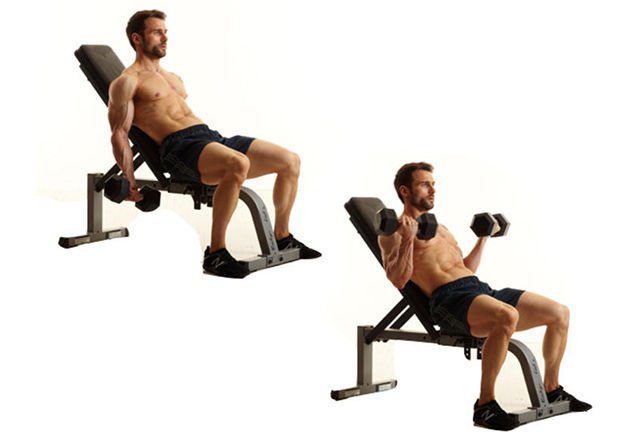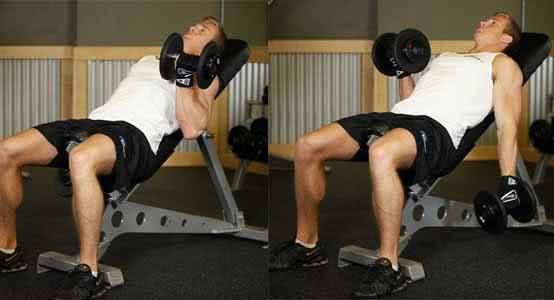
Biceps bending with dumbbells from an inclined seat (from an inclined bench) is a simple movement. The exercise focuses on the upper sectors of the inner and outer heads of the biceps. Brachialis and brachioradialis support folding, and the front shoulder heads are extras or synergists according to the technique of execution. Although simple, the exercise is not recommended for beginners for a number of reasons and features, which are described below.
Features
This type of folding allows for equally good performance of “clean” low-intensity repetitions and “cheating” movements, reducing the load that heavy dumbbells place on the spine.
The control (slowing down) of the inertia during extension has a dynamic stretching on the toned biceps, which increases the microtraumatizing effect and accordingly provokes growth. The position of the elbows relative to the shoulders, in turn, puts the front shoulder heads in a less favorable position of synergists (supporting muscles) compared to the classic folding with standing dumbbells, ie. weakens their influence. This is of great importance in the use of false movements, which we will discuss below. In order to prevent shoulder injuries, it is not recommended to perform the technique on benches with an inclination of less than 45 degrees.
According to the grip:
- Neutral (thumbs up, parallel lines between the wrists-elbows of both hands during the performance) – no accent
- Supinated (thumbs out, elbows closer to the body than the wrists) – emphasis on the inner heads
- Prone (thumbs up and inwards, elbows from one line with wrists in the starting position are directed outwards, wrists – inwards) – emphasis on outer heads
- Variable (parallel position of wrists-elbows, in relation to the body in the whole amplitude of movement, rotation in the wrists) – partial accent, according to the direction of rotation (thumbs outside – outer heads, thumbs inside – inner heads)

According to the synchrony
Simultaneous movement
Suitable for explosive, partial and cheating repetitions, respectively for strength and mass (myofibrillar). It is important in the negative phase of the movement to leave the elbow joints slightly shortened so as not to injure your biceps. Attempts to control weight at an intensity greater than 90% (PM: 5 to 6) with abrupt relaxation of the dumbbells is particularly risky for both biceps and front shoulder heads. The risk increases with increasing angles of the elbow joints, ie. in case you try to / allow gravity and inertia to stretch your elbows. Simply put, do not fully unfold when releasing the dumbbells to the floor, if you have caught ones that allow you to do no more than 8 repetitions.
Alternating
Suitable for long series for strength endurance, endurance and maximum blood supply. Greater retention in the lower position contributes to increased nervous tension of the already toned muscle. Suitable for stress-generating workouts. Do not hold your hands in the down position for more than 3 seconds or all 30 seconds in a row. Use pre-folding-slow unfolding, ie. when the right palm reaches the uppermost point, the left palm has already started moving upwards.
Waiting (first series with left, then series with right)
Not recommended due to unpleasant twisting in the spine. Better not try!
According to the amplitude
Standard (correct)
Elbows do not move or move up to 1-2 fingers during lifting. Standard technique.
Elongated (incorrect)
Elbows move up to 3-4 fingers forward during lifting, and in the middle of the amplitude, begin to move back, in order to avoid the point of rest. It is mainly used for strength endurance and mass in bilateral (bilateral) folding for mass, ie. this is a “cheating” movement. Lifting speed is a key factor in the effectiveness of the technique, but it should not be an end in itself for the safety of the shoulder joints and tendons.

Shortened (incorrect) The
elbows move backwards from the shoulders during the flexion, the biceps are supported by the back shoulder heads. The emphasis on the upper sector of the biceps increases, with a tendency towards the outer heads. The smaller the angle of inclination of the bench, the greater the emphasis and the greater the risk of injury when using false movements.
Execution of biceps flexion from a seat with a parallel grip when tilted
Preparation:
- 1. Adjust the bench to a slope of at least 45 degrees;
- 2. Take the dumbbells and sit without leaning . Place the dumbbells on your thighs;
- 3. Carefully lower them to the side of the bench, leaving your elbows slightly bent;
- 4. Slowly lower your back. In case of shoulder pain, immediately drop the dumbbells to the floor.
Execution:
- 4.1. Extend your elbows completely;
- 4.2. Lift the two dumbbells up and slightly forward, being careful not to move your elbows more than 1-2 fingers;
- 4.3. Hold in the upper position for a split second and lower to the starting position in a controlled manner.
- 4.4. Repeat.
Leaving:
- 5. Or drop the dumbbells on the floor;
- 6. Or bend your body down with a forward bend in your spine (as in an abdominal press) to compensate for the incline and stand up. Place the dumbbells on the bench.
For me, folding dumbbells from a reclining seat is not an exercise suitable for beginners. They would not benefit more from standard dumbbell biceps flexion .
Attention! The implementation in video 2 is extremely risky and contrary to several recommendations described above. Don’t try this at a sports club if you don’t consider yourself a professional.
I do not recommend using movement as a first exercise in biceps programs. There are too many risky moments around the technique of execution, the underestimation of which threatens with growths and twists.
For intermediate and advanced, bending with dumbbells from a slope can bring more benefits to exhausted and well-toned muscles. For this reason, it can be performed as a third or fourth exercise in the biceps program. It is best to turn it on periodically to unlock new growth.


